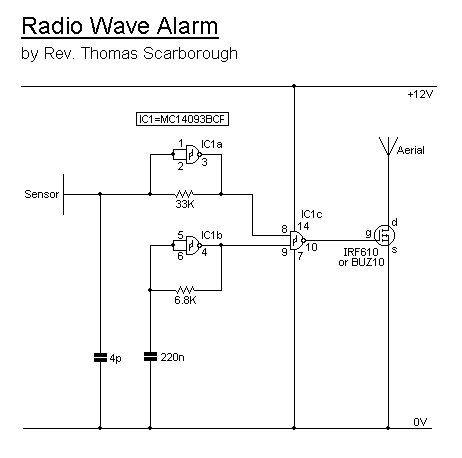
Radio Wave Alarm

This simple circuit is sure to have the police beating a path to your door - however, it has the added advantage of alerting you to their presence even before their footsteps fall on the doormat. The circuit transmits on Medium Wave (this is the small problem with the police). IC1a, together with a sensor (try a 20cm x 20cm sheet of tin foil) oscillates at just over 1MHz. This is modulated by an audio frequency (a continuous beep) produced by IC1b. When a hand or a foot approaches the sensor, the frequency of the transmitter (IC1a) drops appreciably. Suppose now that the circuit transmits at 1MHz. Suppose also that your radio is tuned to a frequency just below this. The 1MHz transmission will therefore not be heard by the radio. But bring a hand or a foot near to the sensor, and the transmitter's frequency changes.
The circuit utilizes an integrated circuit (IC1a) as the primary oscillator, generating a carrier frequency just above 1 MHz. This frequency is suitable for medium wave transmission, which typically operates within the 530 kHz to 1700 kHz range. The oscillator is coupled with a sensor, which can be constructed using a simple sheet of tin foil, measuring approximately 20 cm x 20 cm. The sensor acts as a capacitive element, detecting changes in capacitance caused by nearby objects, such as a hand or foot.
The modulation of the carrier signal is achieved through a second integrated circuit (IC1b), which produces an audio frequency tone. This tone serves as a continuous beep that is superimposed onto the carrier wave. The modulation process ensures that the transmitted signal carries the audio frequency information, allowing for detection by an appropriate receiver.
When an object approaches the sensor, the capacitance changes, leading to a drop in the frequency of the carrier wave produced by IC1a. This frequency shift can be detected by a radio receiver tuned just below 1 MHz. The radio will not pick up the steady 1 MHz signal but will respond to the modulation caused by the frequency change, alerting the user to the presence of an intruder.
In summary, this circuit serves as an innovative alert system that utilizes simple components to provide a non-intrusive means of detecting nearby movement. The use of medium wave transmission and frequency modulation allows for effective operation while minimizing the risk of detection by standard radio equipment.This simple circuit is sure to have the police beating a path to your door - however, it has the added advantage of alerting you to their presence even before their footsteps fall on the doormat. The circuit transmits on Medium Wave (this is the small problem with the police). IC1a, together with a sensor (try a 20cm x 20cm sheet of tin foil) oscillates at just over 1MHz. This is modulated by an audio frequency (a continuous beep) produced by IC1b. When a hand or a foot approaches the sensor, the frequency of the transmitter (IC1a) drops appreciably.
Suppose now that the circuit transmits at 1MHz. Suppose also that your radio is tuned to a frequency just below this. The 1MHz transmission will therefore not be heard by the radio. But bring a hand or a foot near to the sensor, and the transmitter`s 🔗 External reference
The circuit utilizes an integrated circuit (IC1a) as the primary oscillator, generating a carrier frequency just above 1 MHz. This frequency is suitable for medium wave transmission, which typically operates within the 530 kHz to 1700 kHz range. The oscillator is coupled with a sensor, which can be constructed using a simple sheet of tin foil, measuring approximately 20 cm x 20 cm. The sensor acts as a capacitive element, detecting changes in capacitance caused by nearby objects, such as a hand or foot.
The modulation of the carrier signal is achieved through a second integrated circuit (IC1b), which produces an audio frequency tone. This tone serves as a continuous beep that is superimposed onto the carrier wave. The modulation process ensures that the transmitted signal carries the audio frequency information, allowing for detection by an appropriate receiver.
When an object approaches the sensor, the capacitance changes, leading to a drop in the frequency of the carrier wave produced by IC1a. This frequency shift can be detected by a radio receiver tuned just below 1 MHz. The radio will not pick up the steady 1 MHz signal but will respond to the modulation caused by the frequency change, alerting the user to the presence of an intruder.
In summary, this circuit serves as an innovative alert system that utilizes simple components to provide a non-intrusive means of detecting nearby movement. The use of medium wave transmission and frequency modulation allows for effective operation while minimizing the risk of detection by standard radio equipment.This simple circuit is sure to have the police beating a path to your door - however, it has the added advantage of alerting you to their presence even before their footsteps fall on the doormat. The circuit transmits on Medium Wave (this is the small problem with the police). IC1a, together with a sensor (try a 20cm x 20cm sheet of tin foil) oscillates at just over 1MHz. This is modulated by an audio frequency (a continuous beep) produced by IC1b. When a hand or a foot approaches the sensor, the frequency of the transmitter (IC1a) drops appreciably.
Suppose now that the circuit transmits at 1MHz. Suppose also that your radio is tuned to a frequency just below this. The 1MHz transmission will therefore not be heard by the radio. But bring a hand or a foot near to the sensor, and the transmitter`s 🔗 External reference





